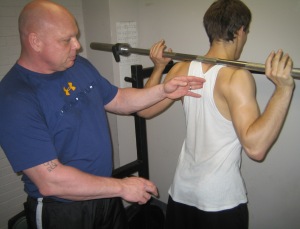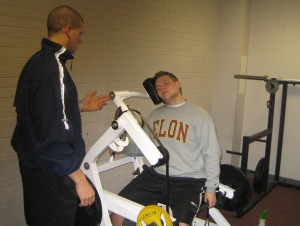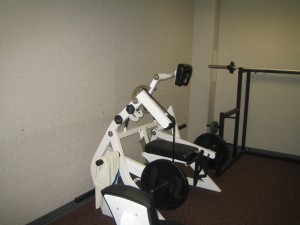Every 20 minutes, a different young man enters a small room in Elon University’s Koury Athletic Center looking energetic, and 20 minutes later the same man exits the room dripping and red-faced. These students aren’t shaping their calves on treadmills or curling their biceps – they’re strengthening their necks.
Each Monday, Wednesday and Friday for the past four weeks, 11 students have been visiting this little room, getting their necks measured and pumping iron with the part of the body few incorporate into their exercise routine. The students are subjects of Ralph Cornwell’s study, “Project Neck,” which researches the effects of consistent neck conditioning, with the goal of preventing damage from concussions.
Cornwell, a Ph.D. candidate in health promotion/human performance at Virginia Polytechnic Institute and State University, is conducting what is — as far as anyone knows — the only study aimed at preventing concussions, instead of fixing them after they occur. His research will also create a neck-strengthening protocol to which Cornwell hopes strength and conditioning coaches will have to adhere in the future.
“This will be the culmination of (my) doctoral dissertation,” said Cornwell. He’s performing his research at Elon because he lives in Greensboro and said, “The atmosphere here is very conducive to learning and experimentation. You get better quality.”
For the dissertation, Cornwell said he will apply the laws of physics to his research’s resulting statistics, and construct a mathematical model that will show the different outcomes of concussion-inducing forces on people who followed his protocol, and those who did not. He said this is the only way to measure the differences without hitting his subjects over the head, which he’s not about to do.
The idea is that the muscles of a strengthened neck will disperse the kinetic energy of a hard force. “The stronger your neck is, the more likely it is to dissipate the energy from a blow,” said Matt Kavalek, Cornwell’s lead research assistant and a sophomore at Elon.
Stronger neck and back muscles would mean increased support, decreasing the odds of a blow jarring the brain inside the skull after a hard blow, which causes a concussion. Cornwell likened strengthened neck and back muscles to an organic “cowboy collar” used by football players for neck support.
Cornwell and Kavalek are already four weeks into the study and are seeing results in the 11 students following the strict protocol Cornwell developed. Three devices are used, two of which are still prototypical, for various exercises focusing on the muscles in the neck or back.
Kavalek said Cornwell worked with anatomists at Wake Forest University to make sure each movement of every exercise has a direct effect on a key neck or back muscle. The exercises include the “tilt,” the “nod,” “laterals,” the “shrug,” the “shrug with head turn,” the “Kelso” and the “Hise shrug.”
But before a study participant launches into his first set of head tilts, Kavalek measures the circumference of his neck, which increases as the muscles gain strength. The study uses only male Elon students, since men aged 18-24 create the best test pool for measurable neck gain, said Cornwell. Since women don’t have the same high testosterone levels as men, their necks wouldn’t get thicker if they did the exercises, and Cornwell’s study needed a physical way to measure progress.
After having his neck measured, the study participant sits in the first prototypical device, a five-way neck machine, and rests the back of his head against a cushion. “It’s the only machine where you can train the muscles in the head and the neck,” said Cornwell. The subject performs the “tilt” and tips his head backward just 25 degrees, which works only the capital muscles — the neck muscles connected to the first two vertebra of the spine — and not the back muscles.
“It’s such a subtle movement, but the back of his head will be on fire,” said Cornwell, as Kavalek counted out 12 repetitions. The subject’s neck is burning because he’s literally lifting weights with his neck. At first, every participant starts each exercise with 10 pounds, but Cornwell increases the weight in increments after the student is able to complete a set with 10 pounds, then 15, and so on.
“We needed a baseline everyone could complete,” said Cornwell. “All the movements are slow and patrolled, so no one gets hurt.” He and Kavalek spot the test subject as he moves onto the “nod,” which is a 10-degree movement forward, as if “you’re acknowledging a friend,” said Cornwell. Then the student performs “laterals,” which is the same movement but to the left and right sides instead of forward.
The next movements, also on the five-way neck machine, target the trapezius – the muscle spanning the neck, shoulders and back, and reaching all the way down to the thoracic (twelfth) vertebrae. The subject performs a “shrug,” and then a “shrug with head turn,” turning the uppermost part of the trapezius, which Cornwell explained happens naturally when you pick up something heavy in a shrug position.
Fifteen seconds after the last set of shrugs, the subject moves to the three-way row machine for the “Kelso,” which is a movement pulling the scapula together and works all the muscles in the back. It’s the movement that test subject Thomas Emery, a sophomore majoring in psychology, said is his least favorite. “You feel it everywhere in your back,” he said.
As Emery fights losing his grips on the machine’s handles during his “Kelso” set, Kavalek cheers him on. “You’re almost there. This is your best set ever. You just need to get angry.” Sweat drips from Emery’s chin as Cornwell moves him to his last movement, the “Hise shrug.” Using squat bar equipment, Emery shrugs with the weighted bar across his back, again targeting his trapezius.
At the end of his training session, Emery is out of breath, which Cornwell said is the norm for most participants. He said he thinks many assumed training one’s neck would be easy, but found out after signing up for the study that it’s not. Kavalek compares the exercises to training a bicep: “If you put (your muscles) against a load, they’re going to get stronger.”
Despite the difficulty, Emery plans to continue neck-strengthening exercises even after the study is completed in another four weeks. And it’s Cornwell’s hope that the exercises Emery and the 10 other Elon students are performing will become part of a protocol required by certifying sports organizations, and will eventually trickle down to the high school and middle school level.
“It’s not an easy protocol by any means,” Cornwell said. But, since no other protocols for preventing concussions exist – in the athletic arena or otherwise – he said, “At least (it will) give them something to go on.”

 Dan Riley had a simple, yet extremely effective approach to neck training. Connected to each neck machine he secured a 60 second timer with a bell. The athlete began each exercise by hitting the start button.
Dan Riley had a simple, yet extremely effective approach to neck training. Connected to each neck machine he secured a 60 second timer with a bell. The athlete began each exercise by hitting the start button. Dan would admonish the athlete for not performing repetitions perfectly. Incorrect form means not activating all the available muscle fibers. “Which muscle fibers in your neck are most important to protect you on Sunday?“, Coach Riley would ask. The players learned to respond “All of them.”
Dan would admonish the athlete for not performing repetitions perfectly. Incorrect form means not activating all the available muscle fibers. “Which muscle fibers in your neck are most important to protect you on Sunday?“, Coach Riley would ask. The players learned to respond “All of them.”
























 Musculus Deltoideus or what we refer to as the ‘delts’ or ‘deltods’ is a large triangular muscle covering the shoulder joint and serving to abduct, flex, extend and rotate the arm.
Musculus Deltoideus or what we refer to as the ‘delts’ or ‘deltods’ is a large triangular muscle covering the shoulder joint and serving to abduct, flex, extend and rotate the arm. The Masseter muscle in proportion to its size is the most powerful muscles in the body. It raises the jaw and clenches the teeth.
The Masseter muscle in proportion to its size is the most powerful muscles in the body. It raises the jaw and clenches the teeth. When you clench down on your mouthguard with your powerful masseter muscle or stiffen your jaw hard to protect yourself prior to contact, the bracing also increases the EMG activity in the musculus deltoideus shoulder region.
When you clench down on your mouthguard with your powerful masseter muscle or stiffen your jaw hard to protect yourself prior to contact, the bracing also increases the EMG activity in the musculus deltoideus shoulder region.


 The Pashby Sports Safety Award is an award presented in Canada to recognize and honor people who make sports and recreational activities safer from catastrophic injuries, which typically involve the eyes, spine or brain. Dr. Karen Johnston MD, PHD was given the Safety Award for her outstanding work to prevent injuries, most specifically concussions.
The Pashby Sports Safety Award is an award presented in Canada to recognize and honor people who make sports and recreational activities safer from catastrophic injuries, which typically involve the eyes, spine or brain. Dr. Karen Johnston MD, PHD was given the Safety Award for her outstanding work to prevent injuries, most specifically concussions. Ralph Cornwell is taking this one step further, building bigger stronger cylinders by developing the musculature around the head, neck and thoracic spine. The developed muscles dissipate more force and ‘clenching’ on the mouthguard with a stronger head, neck and jaw augments the value of dissipation by stabilizing movement. This further reduces the subconcussive forces involved in causing a concussion.
Ralph Cornwell is taking this one step further, building bigger stronger cylinders by developing the musculature around the head, neck and thoracic spine. The developed muscles dissipate more force and ‘clenching’ on the mouthguard with a stronger head, neck and jaw augments the value of dissipation by stabilizing movement. This further reduces the subconcussive forces involved in causing a concussion.














 Musculature attaching above and below this free floating structure allows for a dampening effect that helps limit oscillations of the head.
Musculature attaching above and below this free floating structure allows for a dampening effect that helps limit oscillations of the head.





 There are many athletes who have mastered the squat and are seemingly built to perform this exercise flawlessly. There are many more who have great difficulties due to bio-mechanical weaknesses, injuries from back and shoulder to hands. There are others whose limb lengths are not conducive to the exercise.
There are many athletes who have mastered the squat and are seemingly built to perform this exercise flawlessly. There are many more who have great difficulties due to bio-mechanical weaknesses, injuries from back and shoulder to hands. There are others whose limb lengths are not conducive to the exercise.
 difficult towards the top of the movement. Training this way is similar to training with bands or chains. You will find the resistance is more appropriate for strength training as the design of the machine and its low horn position was made for what the bands and chains are trying to accomplish.
difficult towards the top of the movement. Training this way is similar to training with bands or chains. You will find the resistance is more appropriate for strength training as the design of the machine and its low horn position was made for what the bands and chains are trying to accomplish.








